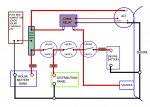pvb
Well-known member
So you are using an emergency switch to disconnect the "both" strap, so allowing the engine start bank to be continuously switched on without it draining to the house side?
That's how I understand it. The standard system, as shown in your picture, is as poorly conceived as the 1-2-Both switch, in that it requires manual intervention.
And then the vsr to direct the charge both separately but at the same time according to need? So if you put the alternator charge to the vsr, then two feeds from the vsr to the load side of the isolators, with the strap cut by your switch, the vsr should sense which bank needs the charge and routes it accordingly.
That's not how VSRs work. The alternator charges one battery; when that battery reaches a certain voltage, the VSR links the batteries together so that they both charge. When the charge voltage is removed, the VSR disconnects the batteries.
If I have finally got my head around it, you have proved that the vsr isnt sensing and routing the charge correctly, you however have proved you can do it manually by closing the strap switch? Uf so, go back a few posts and your vsr aint working properly?
Stu
Maybe, but it may just be incorrectly wired.

